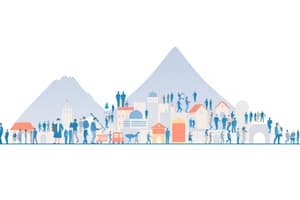Podcast
Questions and Answers
What does population growth refer to?
What does population growth refer to?
- The steady state of the number of people over time
- The random fluctuation in the number of people over time
- The decrease in the number of people over time
- The increase in the number of people over time (correct)
How is population growth quantified?
How is population growth quantified?
- By measuring the total number of deaths only
- By analyzing the employment rates
- By estimating the immigration and emigration rates
- By calculating the difference between births and deaths (correct)
How is the rate of population growth measured?
How is the rate of population growth measured?
- By calculating the percentage change in the population size over a specific period (correct)
- By assessing the literacy rates within the population
- By analyzing the average household income
- By determining the average age of the population
Which factor significantly impacts population growth?
Which factor significantly impacts population growth?
What are some factors contributing to falling fertility rates globally?
What are some factors contributing to falling fertility rates globally?
How does migration impact population growth?
How does migration impact population growth?
According to the United Nations, what is the expected global population by 2050?
According to the United Nations, what is the expected global population by 2050?
What are some implications of population growth mentioned in the text?
What are some implications of population growth mentioned in the text?
How does urbanization impact population growth according to the text?
How does urbanization impact population growth according to the text?
What are some implications of falling fertility rates mentioned in the text?
What are some implications of falling fertility rates mentioned in the text?
Flashcards are hidden until you start studying
Study Notes
Exploring Population Growth: Understanding the Core Aspect of Human Dynamics
Population growth, a fundamental aspect of human demographics, refers to the increase in the number of people over time. This subject is crucial to understanding the intricate interplay between societies, resources, and global development. In this article, we will delve into the dynamics and implications of population growth, shedding light on the critical subtopic of population growth trends.
The Basics of Population Growth
Population growth is quantified by measuring the total number of births and deaths in a given period, typically a year. The net increase in the population is determined by calculating the difference between births and deaths. When the number of births exceeds the number of deaths, the population grows. Conversely, when more people die than are born, the population declines.
Population Growth Rates
The rate of population growth is measured by calculating the percentage change in the population size over a specific period. For instance, if a population of 100,000 people grew by 10,000 people in a year, the growth rate would be 10% (10,000 divided by 100,000, multiplied by 100).
Factors Affecting Population Growth
- Fertility rates: The number of children born per woman during her reproductive years significantly impacts population growth. Fertility rates have been falling globally, particularly in developed countries, due to factors such as increased access to contraception, abortion, and better education.
- Life expectancy: Advances in medicine, public health, nutrition, and lifestyle improvements have led to higher life expectancy, resulting in larger populations.
- Migration: People moving into or out of a region can also impact population growth. For instance, if more people move into an area than those leaving, the population will increase.
Population Growth Trends
Global population growth has peaked and is expected to slow down in the long term. The United Nations predicts that the global population will grow from 7.9 billion people in 2024 to 8.5 billion in 2030 and 9.7 billion by 2050. The world's population is expected to stabilize at around 10.4 billion by 2100.
- Regional differences: While some regions, such as Africa, are expected to experience rapid population growth, others, like Europe and Japan, are projected to age and experience a decline in population.
- Urbanization: Population growth is shifting towards cities, particularly in developing countries. As a result, urban centers are expanding rapidly, creating challenges related to infrastructure, housing, and resource management.
Implications of Population Growth
Population growth has significant implications for the world we live in. Some of the most critical implications include:
- Resources: As the population grows, there is increased demand for resources, including food, water, housing, energy, and other essential commodities. This can lead to resource scarcity, environmental degradation, and social unrest.
- Economic development: Population growth can impact economic development by increasing the demand for goods and services, creating labor markets, and shaping public policy.
- Environment: Rapid population growth can exacerbate environmental challenges, such as climate change, deforestation, and pollution.
- Social issues: Population growth can create challenges related to education, healthcare, and social welfare. For instance, when a large number of children enter the education system simultaneously, it can strain the educational infrastructure.
Population growth is a complex and multifaceted topic that is critical to understanding the world around us. As the global population continues to grow, it will be essential to address the challenges that arise from population growth and to work towards sustainable development. By understanding the factors that affect population growth, we can better anticipate and respond to the challenges that lie ahead.
Studying That Suits You
Use AI to generate personalized quizzes and flashcards to suit your learning preferences.




